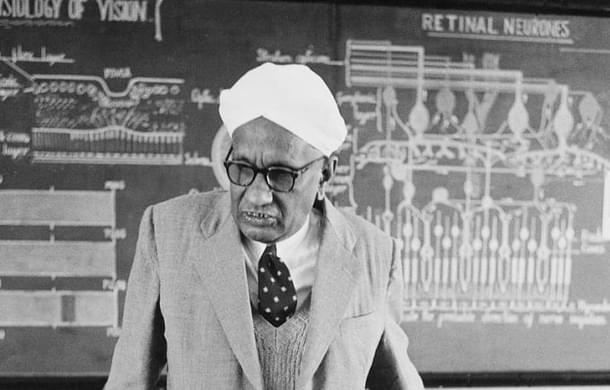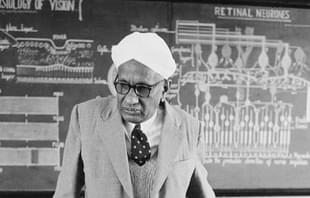Featured
From the Archives: Sir C.V. Raman
Swarajya Archives
Nov 21, 2014, 08:44 PM | Updated Feb 24, 2016, 04:18 PM IST
Save & read from anywhere!
Bookmark stories for easy access on any device or the Swarajya app.


(Today marks the 44th death anniversary of India’s greatest Physicist and Nobel Prize Winner Shri C.V Raman. Swarajya pays tribute with this obituary written by Shri A. Ranganthan that was published in our December 12th, 1970 issue)
In his delightful book, A Mathematician’s Apology, the renowned British mathematician G. H. Hardy observed that “The mathematician’s patterns, like the painter’s or the poet’s must be beautiful; the ideas like the colours or the words must fit together in a harmonious way.”
Chandrasekhara Venkata Raman was inspired by this quest for beauty in his scientific career. Indeed Raman’s scientific investigation on the colour of the sea and of ice in glaciers, the origin of colours in the plumage of birds, iridescent shells and flowers, the whispering gallery phenomenon in St. Paul’s Cathedral, the architecture of crystals, the structure of the diamond, the physical theory of musical instruments can be perceived as an exquisite symphony of light, colour and form, sound, harmony and rhythm.
Raman’s earliest experiments in both optics and acoustics were conducted while he was a student. In 1906 appeared his first paper on the diffraction bands of light, a subject which he was to make peculiarly his own in his later career. Already well known-for his contributions to musical acoustics, he began his work on the scattering of light in 1919 at Calcutta. During a voyage to Europe, Raman observed the blue opalescence of the Mediterranean Sea. Formerly the blue colour of sea was attributed to the reflection of blue sky light, or the presence of suspended matter.

It struck Raman, however, that the phenomenon owed its origin to the scattering of light by the molecules of the water. In order to verify this explanation, he conducted a series of experiments on the scattering of light. And in the wake of these experiments, Raman announced his discovery that if monochromatic light was passed through a transparent liquid, the light scattered by the contained not only the light of that colour but also undergoes a change of frequency. This great discovery, known as the ‘Raman Effect’ (predicted by Smekal in 1923), won international recognition for Raman, including the award of the Nobel Prize for Physics in 1930. The Raman Effect was not only a brilliant experimental confirmation of the new physics based on the quantum theory, but also an effective tool in the study of the structural problems of chemistry.
Indeed the discovery of the Raman effect unveiled a vista of research during the thirties which paralleled the early history of work in X-rays and radio-activity. The discovery of the Laser (Light Amplification by Stimulated Emission of Radiation) has led to a revival ‘of interest in Raman spectroscopy.
Although Raman was essentially a great experimental physicist, he also made distinguished contributions to theoretical physics. Apart from his theoretical formulation of the Raman effect, Raman also made theoretical predictions concerning the behaviour of ultrasonic waves, which were confirmed by a group of scientists at the Columbia Radiation Laboratory twenty-five years later in 1963. The theory formulating Raman’s discovery that a beam light passing through a liquid in which ultrasonic waves are maintained is split into a series of new beams which can be controlled by varying the ultrasonic waves has been used in various high speed information processing systems and in experimental television systems. The Columbia group of scientists used a red helium-neon Laser and have confirmed Raman’s prediction (with an accuracy of more than one part in a million) that the colours of the light beam emerging from the liquid should vary slightly from the colour of the inicident beam.
Raman was a great populariser of scientific ideas. His book,’The New Physics’ (Philosophical Library,New York, 1951) dealing with a variety of subjects such as water, soil, weather, atmospheric electricity, the structure of crystals, cosmic rays and the stellar universe is at once a sensitive prose and a brilliant piece of scientific exposition. Raman was not only one of the foremost leaders of the heroic age of modern physics, but also opened a view of the new physiological world of perception.
It was an, aesthetic experience to observe Raman in a state of rapture as the mellow sunset and the soft breeze transfigured the quivering leaves and flowers of his own garden into a colourful panorama of visual perception. For Raman was an artist in his perception of visual aesthetics. Indeed he has compared the scenic beauty of water in a landscape to the eyes of the human face as “It reflects the mood of the hour, being bright and gay when the sun shines, turning to dark and gloomy when the sky is overcast.” Raman even arranged the glittering collection of his medals in the order of their aesthetic merit.
While reflecting on Raman’s achievement, one is reminded of what G. M. Trevelyan said in another context: “He was an outstanding example of a type that has always attracted me; the specialist who has a wide outlook; broad knowledge and warm enthusiasms outside his own subject as well as in it, and more particularly, a man he was whose mind has been trained in the splendid discipline’ of science, but whose heart and eyes also take delight in the triumphs of art, in the history of man, in the beauties of nature. Such a man is about the best thing that our modern civilization can produce”.
Selections from Swarajya's 40,000 pages of archives since 1956.





